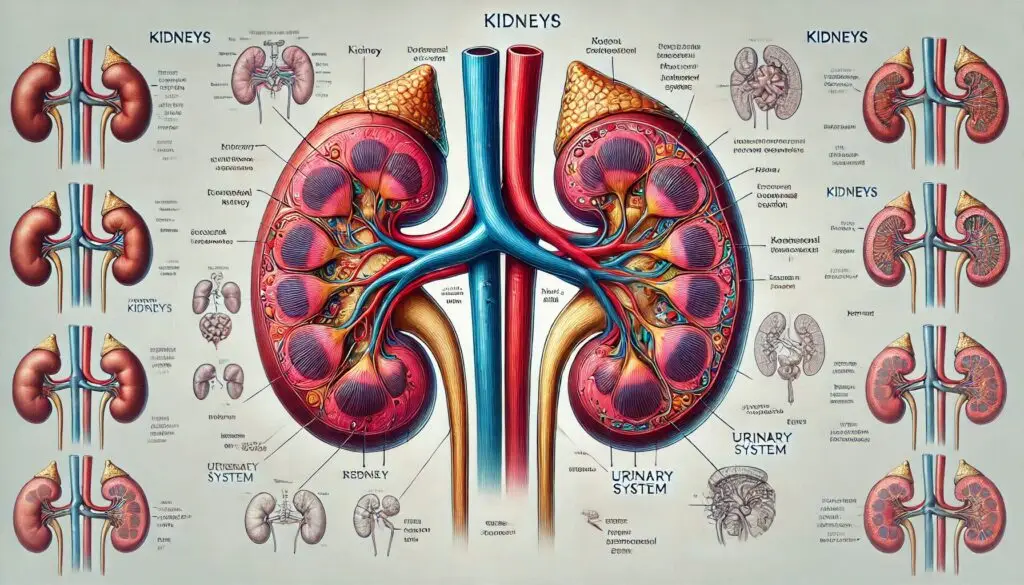Kidneys in Livestock

Introduction
Kidneys are vital organs in livestock. They filter blood, remove waste, and regulate fluid balance. Understanding kidney health is essential for farmers and veterinarians. This article delves into the anatomy of kidneys in various livestock species, common diseases affecting them, and effective management practices.
Importance of Kidney Health
Healthy kidneys ensure that livestock thrive. They play a crucial role in metabolic processes and overall well-being. When kidneys fail or become diseased, it can lead to severe health issues. Therefore, proactive management is key.
Anatomy of Kidneys in Livestock
Structure of Kidneys
The kidneys of livestock vary by species but share common structures. Each kidney consists of three main parts: the capsule, parenchyma, and renal pelvis.
Capsule
The capsule is a thin outer layer that protects the kidney. It is typically light brown and helps maintain the shape of the organ.
Parenchyma
The parenchyma includes two layers:
- Cortex: The outer layer responsible for filtering blood.
- Medulla: The inner layer that collects urine.
Renal Pelvis
The renal pelvis is where urine collects before moving to the bladder. This structure is essential for urine transport.
Kidney Size Across Species
Kidney size varies significantly among livestock species. For instance, the average horizontal diameter of kidneys in Bali cattle ranges from 16.31 to 18.2 cm. In contrast, Holstein Friesian cattle have larger kidneys, averaging between 19-26 cm in length.
Common Kidney Diseases in Livestock
Understanding common kidney diseases helps in early detection and treatment. Here are some prevalent conditions:
Pyelonephritis
Pyelonephritis is one of the most common kidney diseases in cattle. It involves inflammation of the renal pelvis and parenchyma due to bacterial infections. Symptoms include fever, lethargy, and changes in urination patterns. For more information on pyelonephritis, visit Merck Veterinary Manual.
Nephritis
Nephritis refers to inflammation of the kidney tissue itself. This condition can arise from infections or toxins. Symptoms may include swelling and pain in the abdominal area.
Urolithiasis (Urinary Stones)
Urolithiasis occurs when stones form in the urinary tract. These stones can block urine flow and cause severe pain. It’s more common in male livestock due to their anatomy.
Chronic Kidney Disease (CKD)
Chronic Kidney Disease is a progressive loss of kidney function over time. Early signs may be subtle but include increased thirst and urination. Regular veterinary check-ups can help monitor kidney health.
Incidence of Kidney Damage
Research shows varying incidences of kidney damage among different livestock species:
- In adult cattle, approximately 40.46% show signs of kidney damage.
- In ewes (female sheep), the incidence is around 3.01%.
- Does (female goats) have an incidence rate of about 2.68%.
- Among fattened animals, kids (young goats) show a low incidence rate of 0.21%, while lambs have 0.42%.
- Bulls exhibit a higher rate at 10.46%, and finisher pigs have an incidence of 14.42%.
These differences highlight how age and stress factors impact kidney health across species.
Factors Affecting Kidney Health
Several factors influence kidney health in livestock:
Nutrition
Proper nutrition is vital for maintaining healthy kidneys. A balanced diet ensures that animals receive essential nutrients without excesses that could harm their kidneys.
Hydration
Adequate water intake is crucial for kidney function. Dehydration can lead to concentrated urine and increased risk of urinary stones.
Stress Management
Stress can negatively impact kidney health. Providing a comfortable environment helps reduce stress levels among livestock.
Regular Veterinary Care
Routine veterinary check-ups are essential for monitoring kidney health. Early detection of issues can lead to better outcomes.
Management Practices for Healthy Kidneys
Effective management practices can help maintain optimal kidney function in livestock:
Monitoring Water Intake
Ensure that animals have constant access to clean water. Monitor their water intake regularly to detect any changes that may indicate health issues.
Balanced Diet Formulation
Work with a veterinarian or animal nutritionist to formulate a balanced diet tailored to your livestock’s needs.
Regular Health Check-ups
Schedule regular veterinary visits for health assessments and screenings for kidney diseases.
Stress Reduction Techniques
Implement stress reduction techniques such as proper housing, socialization opportunities, and appropriate handling practices.
Conclusion
Kidney health is vital for the overall well-being of livestock. Understanding the anatomy and common diseases associated with kidneys empowers farmers to take proactive measures for prevention and treatment. By focusing on nutrition, hydration, stress management, and regular veterinary care, you can ensure your livestock remain healthy and productive.
More from Veterinary Anatomy:
Bright Field Microscopy





Responses